China–Myanmar relations
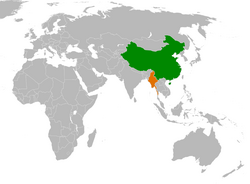 | |
China |
Myanmar |
|---|---|
| Envoy | |
| Ambassador Ma Jia | Ambassador U Tin Maung Swe |
China–Myanmar relations (Chinese: 中缅关系; Burmese: တရုတ်မြန်မာဆက်ဆံရေး) are the international relations between the People's Republic of China and Myanmar. China and Myanmar have active bilateral relations with each other. The relation is often described as a pauk-phaw relationship (Burmese: ပေါက်ဖော်), based a Burmese term for kinsfolk that implicates special asymmetric obligations between the two countries.[1][2][3]
Generally, China has maintained positive relationships with both military and elected governments in Myanmar. In recent years, bilateral relations between China and the current Myanmar government (Junta) have faced difficulties due to alleged Chinese backing of rebels in Myanmar's territories.[4][5] In recent years, the relations between China and Myanmar have faced some problems due to ongoing clashes between ethnic Chinese rebels and the Myanmar military near the China–Myanmar border.[6]
History
[edit]Both two countries and peoples, as well as both countries' official languages, share a close relationship and the same linguistic link, in which both the Burmese and Chinese are both parts of Sino-Tibetan language family and peoples.
The Yuan dynasty saw the First Mongol invasion of Burma and Second Mongol invasion of Burma. The Qing dynasty fought the Sino-Burmese War. Both countries had conflicting claims on the Chinese Shan states ever since the Toungoo Empire rose to power, though trade with Ming China was beneficial for the Toungoo Empire. Ming loyalists escaped to Burma during the Manchu invasion of China. Large numbers of Panthays from China also settled in Myanmar.[7][8]
China |
Burma |
|---|---|
Immigration from China to Burma also increased after the country was colonized by the British empire.[9]: 140 Chinese in Burma were an important minority community, especially in urban centers.[9]: 140 The British colonizers used a divide-and-rule strategy on the basis of ethnicity, placing the majority Bamar people at the bottom of the social and economic order.[9]: 140 This resulted in resentment by Bamar people against Chinese and other immigrant communities viewed as benefiting from colonialism, including Indians in Burma.[9]: 140
The Burma Road was built to China during World War II.
Modern relations
[edit]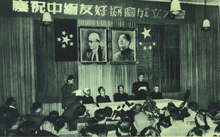
Recognition
[edit] | |
China |
Burma |
|---|---|
Burma was the first non-Communist country to recognize the Communist-led People's Republic of China after its foundation in 1949.[10] According to India's ambassador to China at the time, Panikkar, Burma was anxious to be the first outside the Soviet bloc and asked India to delay their recognition by a few days so they could be first.[11]
On 16 December 1949, Burma's Foreign Minister Aye Maung gave a note to Zhou Enlai that Rangoon “decide to recognize PRC, and hope to establish diplomatic relations and exchange diplomatic envoys.”[12] Mao Zedong sent a telegram to Liu Shaoqi and Zhou Enlai on 19 December to ask Burma for their willingness to cut off diplomatic relations with the Kuomindang.[13]
Zhou replied to Burma that Beijing agreed to establish diplomatic relations and exchange diplomatic envoys on the premise of breaking relations with the Kuomintang government.[12] His message further asked Burma's government to dispatch a negotiator to Beijing.[14] Burma's new Foreign Minister, Zaw Hkun Zhuo informed Zhou on 18 January 1950 that the Republic of China's embassy had been notified and would be closed. Additionally, Rangoon appointed U Phyo, the consul general in Kunming, as temporary chargé d'affaires to establish diplomatic relations with the new China.[15]
In late April, Burma's negotiator U Phyo arrived in Beijing and held three negotiations with Zhang Hanfu, China's Vice-Foreign Minister, discussing how Burma severed relations with Kuomintang and disposed of all Kuomintang organizations and estates in Burma.[14] Zhang replied on 19 May 1950 that China's government was satisfied with negotiations.[citation needed]
Rangoon sent ambassador Myint Thein to present his credentials but was advised that one of Mao's deputies would see them. Myint Thein refused on the grounds that he was presenting from one head of state to another, and could not present to anyone lesser.[1] On 8 June 1950, Mao Zedong accepted the credentials from Myint Thein in Beijing and formally established diplomatic relations between the Burma and the People's Republic of China. The Union of Burma officiated its embassy in Beijing on the same day, becoming the sixteenth country establishing relations with the new China.[citation needed]
On 28 June, the PRC opened its embassy in Rangoon. Yao Zhongming, China's first Ambassador to Rangoon arrived in Rangoon on 28 August and presented his credentials on 5 September 1950 to Sao Shwe Thaik.[16]
Mid-20th century relations
[edit]In the early 1950s, Chinese Nationalist forces who had been defeated in the Chinese Civil War crossed into Burma and fled into the hills of the Wa region.[17]: 103 Communist forces pursued them.[17]: 103 With support from the United States, the Nationalist forces reorganized and from 1950 to 1952, launched unsuccessful attacks into Yunnan, China.[17]: 103 In 1953, Burma's government raised this violation of its sovereignty by the Chinese Nationalists to the United Nations.[17]: 103 These incidents became part of the motivation for rapidly expanding and modernizing Burma's armed forces, the Tatmadaw.[17]: 103
With the symbol of exchange visit between two Premiers, Zhou Enlai and U Nu, in 1954, China-Burma relations began to boom.[18] China and Burma signed a treaty of friendship and mutual non-aggression and promulgated a Joint Declaration on 29 June 1954, officially basing their relations on the Five Principles of Peaceful Co-existence.[10][19] The relationship with China was under the spirit of the term "pauk-phaw", meaning kinship in Burmese. However, Burma maintained a neutralist foreign policy in the 1950s and 1960s.
In 1957, tensions between the two countries increased when Chinese forces entered the Wa in search of Nationalists.[17]: 104
After decades of negotiations between the Chinese and British before, the China-Burma border was finalized in 1960 by then Prime Minister Ne Win and Zhou Enlai.[17]: 13 The border agreement resolved several Chinese claims, including conceding the Namwan Assigned Tract to Burma in exchange for three Kachin villages and a small portion of Wa State to be returned to China. The agreement furthered the relationship between the PRC and Ne Win, who returned to his military position following the 1960 Burmese general election and led to a joint Burmese-PRC military operation taking out the KMT stronghold in Mong Pa Liao near the China–Laos border.[20] By 1960, KMT forces had mostly left the Wa Region.[17]: 104 The Burma government made a series of agreements with China during the 1960s to address the continued problems of Chinese Nationalist guerillas.[17]: 105
After his 1962 coup, Ne Win enacted a Burmanization of the economy, leading to the expulsion of many Chinese (along with Indians).[9]: 141 Ne Win's government prohibited foreigners from owning land and practicing certain professions.[9]: 141
Anti-Chinese riots in 1967 and the expulsion of Chinese communities from Burma generated hostility in both countries.[19] Following the riots, China increased its support to the Communist Party of Burma, which was fighting the Burmese government.[17] : 105
Relations began to improve significantly in the 1970s. Under the rule of Deng Xiaoping, China reduced support for the Communist Party of Burma and on 5 August 1988, China signed a major trade agreement, legalizing cross-border trading and began supplying considerably military aid.[citation needed]
Relations under military rule
[edit]This section needs expansion. You can help by adding to it. (March 2023) |
Following the violent repression of pro-democracy protests in 1988, the newly formed State Peace and Development Council, facing growing international condemnation and pressure, sought to cultivate a strong relationship with China to bolster itself; in turn, China's influence grew rapidly after the international community abandoned Burma.[19][21]
Jiang Zemin visited Myanmar in 2001.[9]: 23
2010s relations
[edit]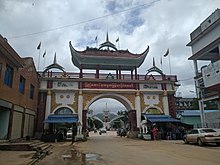
After the Kokang incident in August 2009 which gained international media interest,[22] some experts questioned its impact on China–Myanmar relations, which were considered to be strong.[23] Bertil Lintner stated that Myanmar was prioritizing internal conflicts over its ties with China,[24] however some Chinese analysts, such as Shi Yinhong, played down the relationship between Myanmar and China, saying "They're not great friends. They don't listen to what China says."[24] China had urged Myanmar to ensure the stability of the border area and protect the interests of its citizens in Myanmar.[25][26] The Burmese Foreign Ministry later apologised to China about the incident, but also ran a story on the Dalai Lama in the government newspaper the Myanmar Times, the first mention of him in the state controlled Burmese media for 20 years.[27] Chinese officials were said to be "furious" and "extremely upset" over not being forewarned about the offensive on the border.
During the presidency of Myanmar's Thein Sein, there were some setbacks in the relationship with China.[9]: 24 In 2015, the Kokang (via the Myanmar National Democratic Alliance Army) began an offensive against the Tatmadaw.[17]: 137 In the course of the fighting, bombs dropped by the Myanmar government landed in China, killing five Chinese civilians.[17]: 137 China viewed the Tatmadaw as having acted with disregard for Chinese security.[17]: 137
In June 2015, Kokang rebels announced a unilateral ceasefire citing "the Chinese government's strong calls for restoring peace in the China–Myanmar border region" among other interests. The announcement coincided with Aung San Suu Kyi's meeting with Xi Jinping, General Secretary of the Chinese Communist Party in Beijing.[28] Following international condemnation of the Rohingya genocide, observers have noted that Myanmar has tightened its relations with China.[29]
The Chinese government formally engaged with the Federal Political Negotiation and Consultative Committee (FPNCC) and also recognised the FPNCC as an EAO negotiation body with the Burmese central government.[30] The FPNCC is the largest negotiating body of Ethnic Armed Organisations, mostly consisting of groups that did not sign the 2015 Nationwide Ceasefire Agreement.[31]
In May 2018, China condemned Myanmar's government after violence in northern Myanmar erupted.[citation needed] The violence was started by a China-backed militia, rebelling against Myanmar. The militia, the Ta'ang National Liberation Army, sought to get more autonomy from the Burmese central government.[5] In October 2018, the China-backed United Wa State Army (UWSA) expelled numerous clergies in northern Myanmar, alleging that some Christian groups contained members aligned to U.S. intelligence organizations.[32] According to Union of Catholic Asian News, the UWSA also forbid northern Myanmar's Catholic Christian minority from expressing their religious beliefs, even inside their homes.[32]
In August 2018, The Irrawaddy found a staggering rise in Chinese projects in Myanmar, which may cause ‘debt traps’ against Myanmar.[33] Despite this, Myanmar's government continued with the Chinese loans and programs in November 2018, causing wide public concern.[34] In February 2019, Myanmar pursued more Chinese-sponsored loans and programs.[35]
In July 2019, UN ambassadors from 50 countries, including Myanmar, have signed a joint letter to the UNHRC defending China's treatment of Uyghurs and other Muslim minority groups in the Xinjiang region.[36][37]
In January 2020, Chinese President Xi Jinping met with State Counsellor Aung San Suu Kyi to discuss the cooperation between the two countries, the first state visit between the two countries in two decades.[38] Xi also met Commander-in-Chief Min Aung Hlaing within Nay Pyi Taw. Xi promoted practical cooperation under the framework of the One Belt One Road to achieve results at an early date and benefit Myanmar's people.[39]
Relations were generally positive between Myanmar and China during the Aung San Suu Kyi era.[9]: 24 In March 2017, China and Russia blocked a UN Security Council Resolution on the Rohingya situation when Auu San Suu Kyi's government was the subject of criticism for ethnic cleansing in Rakhine state.[9]: 24 A year later, China opposed British efforts for the UN Security Council to issue a statement calling on Myanmar to prosecute those responsible for attacks on the Rohingya.[9]: 25
Complications with Junta
[edit]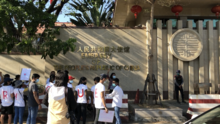
In February 2021, the Myanmar coup d'état removed a number of democratically elected members of parliament from power, including State Counsellor Aung San Suu Kyi. On 3 February, China and Russia blocked the United Nations Security Council from issuing a statement condemning the military for fear of additional economic sanctions. China generally opposes the use of sanctions, and considers them counterproductive in the case of Myanmar.[9]: 26 While the PRC initially downplayed the military coup as "a major cabinet reshuffle", it later expressed concern over the 12-month emergency declared by military leader Min Aung Hlaing, demanding the release of Aung San Suu Kyi.[40]
On 16 February 2021, in reaction to protesters outside the Chinese embassy in Yangon, blaming China for the coup d'état, the Chinese ambassador Chen Hai said “the current development in Myanmar is absolutely not what China wants to see”. He dismissed the claim that China supports military rule in Myanmar as a “ridiculous rumour”.[41] Nonetheless, Chinese factories in the country were set ablaze as Burmese protesters did not trust China's response, leaving 39 people dead on 15 March; the Chinese embassy in Myanmar later responded by condemning the arson attacks, but was ridiculed by the protesters for not offering any sympathy to the protest movement.[42][43] China also continued to supply food to Myanmar, which was seen by some as supportive of the military junta.[44][45]
In mid-March 2021, China–Myanmar relations had seriously frayed due to ongoing civil unrest and military rule, jeopardizing Chinese investments in the country. In another report, it was stated that Myanmar's junta is trying to improve relations with the United States through the employment of a former Israeli military intelligence official. According to the source, Aung San Suu Kyi had grown too close to China for the generals’ liking. China has not supported military rule in Myanmar and attempts to resolve the conflict peacefully without foreign interference.[46][47] Despite these statements, China has been, alongside Russia, frequently vetoing any UN resolutions condemning the increasing brutality of the Burmese military junta for fear of additional sanctions that would hurt the region economically. China is the second largest investor in Myanmar.[48][49]
On 3 May 2021, China sent over 500,000 vaccines made by Chinese firms Sinovac and Sinopharm to Myanmar in order to combat the COVID-19 pandemic and to demonstrate the friendship (Paukphaw). The vaccines were previously approved by the WHO and represented a significant step to protect all citizens of Myanmar from the deadly disease.[50] Anti-vaccine protesters considered it a sham, and distributed misinformation about Chinese vaccines on social media.[51]
In November 2021, China sent a special envoy led by diplomat Sun Guoxiang to Myanmar.[9]: 26 Sun met with the military junta leadership while also demanding to see Aung San Suu Kyi, which was denied by junta authorities. After the visit, China's Foreign Ministry stated that China supported Myanmar's cooperation with ASEAN in implementing the Five-Point Consensus and that China opposed "undue external intervention."[9]: 26
China later invited a member from National League for Democracy (NLD) to a virtual summit for political parties in South and Southeast Asia. Analysts believe China would mediate the conflict and support the faction they deemed capable of imposing stability and protecting Chinese investments.[52] As the civil war went on, China gradually began to support the junta, pushing them toward China's sphere of influence with capital investments.[53]
In July 2022, Chinese Foreign Minister Wang Yi visited Myanmar, the first official visit since the military coup. United States Institute of Peace analysts believed China had chosen the junta over the pro-democracy National Unity Government (NUG) and other rebellion movements, as Beijing deemed the latter too weak to challenge the regime.[54] However, China has also been reluctant to fully embrace the military junta, with Chinese premier Li Keqiang not attending the Lancang-Mekong Cooperation held in Myanmar in late 2022, leading to the summit's cancellation.[55] Additionally, the NUG has called on its defense forces, the People's Defence Force, to not target Chinese projects, and reportedly send congratulatory letters along with the NLD to Chinese Communist Party general secretary Xi Jinping after the 20th CCP National Congress in October 2022.[55] On November 11, 2022, U Tin Maung Swe was appointed Ambassador to the People's Republic of China.[56]
Due to the coup, the Junta's control over the border severely deteriorated, leading to cross-border crime, and threatening China's national security and public support.[57] On 2 May 2023, Chinese foreign minister Qin Gang visited Myanmar. Beijing side strongly demanded that the Junta address the criminal activities on its border.[57] It also demanded Junta leaders, which traditionally held anti-Chinese sentiment, change their course in exchange for support.[58] Analysts believed Beijing's warm-up with Junta was driven by self-interest and reactionary hedging to the American BURMA Act, which Beijing sees as Washington's attempt to grow influence in the region.[58][59] However, the lucrative cross-border scam operations were run by Junta allies, making Junta reluctant to crack them down, frustrating Beijing.[60]
This gave the opportunity for resistance groups in Myanmar to align themselves with the Chinese.[61] During Operation 1027, China issued arrest warrants for junta-aligned Ming Xuecheng and three others for their involvement in online scamming operations.[62] According to The Diplomat, this move signals China's "tacit support for the removal of the Kokang SAZ's leadership".[63] In November 2023, junta supporters held protests against China in Naypyidaw and Yangon where they accused Beijing of supporting Operation 1027 rebels.[64][6] In January 2024, Myanmar extradited ten individuals connected to the scam ring, including a warlord named Bai Suocheng, to China.[65]
Commercial relations
[edit]Like Sino-Burma political relations, the economic ties also shifted in 1954. On 22 April 1954, China and Burma signed the first economic trade agreement which was valid for three years. According to the agreement, China exported coal, silk, silk fabrics, cotton fabrics, paper, agricultural implements, light industry product, handicraft, porcelain enamel, porcelain, can food, tea, and cigarette to Burma. Burma exported rice, rice product, pulse seedcake, mineral, timber, rubber and cotton to China. On 3 November 1954, both signed goods exchange protocol of Burmese rice and Chinese commodities, and the contract that China bought 150,000 long tons Burmese rice.[18]
Trade between China and Myanmar was nearly non-existent prior to 1988.[66] After the imposition of international economic sanctions in 1988, Myanmar-China trade grew 25% year-to-year until 1995, with some decline following the 1997 Asian financial crisis.[66]
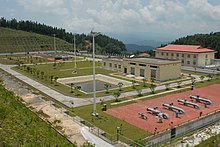
As of 2020–2021, bilateral trade between China and Myanmar exceeded $9.8 billion.[67] Chinese exports to Myanmar typically focus around oil, steel and textile products, while Myanmar exports to China range from natural rubber to raw wood.[67]
In China's view, its cross-border trade with Myanmar is its most successful example of trade engagement with its smaller south western neighbors.[66] Among all of the countries on China's southwest border, Myanmar has achieved the highest level of integration of transportation networks with China.[68]
Effective 1 December 2024, China eliminated tariffs for goods imported from all of the countries that the United Nations categorizes as least developed and with which China has diplomatic relations, including Myanmar.[69]
Infrastructure
[edit]Myanmar is a significant component of the Belt and Road Initiative.[70]: 211 In an effort to decrease China's reliance on shipping through the Strait of Malacca, China has built oil and gas pipelines that run to China from the Bay of Bengal.[70]: 211 The deepwater port being enhanced in Kyaukphyu provides a link to these pipelines, and a gateway to the Bangladesh-China-India-Myanmar (BCIM) Economic Corridor.[71]: 67
China is providing extensive aid and helping to develop industries and infrastructure in Myanmar and aims to be the chief beneficiary from cultivating Myanmar's extensive oil and natural gas reserves.[72] It is one of the chief partners of Myanmar in the project to renovate and expand the Sittwe seaport and has received rights to develop and exploit natural gas reserves in the Arakan region.[19] China has offered loans and credit, as well as economic aid and investments for the construction of dams, bridges, roads and ports as well as for industrial projects.[10][19]
Energy
[edit]Chinese enterprises, including both state-owned enterprises and private companies, have invested heavily in hydroelectric power, oil and gas exploration, and natural resources in Myanmar.[17]: 18 Chinese firms have been involved in the construction of oil and gas pipelines stretching 2,380 km (1,480 mi) from Myanmar's Rakhine State to China's Yunnan Province.[72] China National Offshore Oil Corporation and the China National Petroleum Corporation hold important contracts on upgrading Burmese oilfields and refineries and sharing of production.[19] PetroChina is in process of building a major gas pipeline from the A-1 Shwe oil field off the coast of the Rakhine State leading to Yunnan, accessing and exploiting an estimated 2.88 to 3.56 trillion cubic feet of natural gas.[19][73] A proposed Sino-Burmese oil pipeline off the western coast of Myanmar may permit China to import oil from the Middle East, bypassing the Strait of Malacca.[19][72] There have been protest against Chinese oil projects.[74]
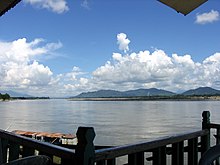
China Power Investment Corporation's investment in the $3.6 billion Myitsone hydropower station on the Irrawaddy River has hit a snagged in early October 2011 as Burmese government suspended construction due to local residents' concern about the human, environmental impact and perceived benefits.[75][76] Local residents said there was a lack of community feedback in the planning process.[76] China's government is stating Myanmar will get US$54 billion in tax revenue, shared profits, free electricity.[76] At stake is China's huge financial stake in the project and also risk to other big projects China has in the country.[76] China Power Investment Corporation stated only five villages with a total of 2,146 needed to relocated. The firm has provided affected villagers with two storey houses, 21 inch televisions and a 100,000 Burmese kyat.[76]
Minerals
[edit]Myanmar is China's key supplier not only for copper but also for rare earth metals required for high tech devices. More than 70% of China's production quota (35.5 t) is sourced from Myanmar (2020). While mining production continued steadily after the military coup in early 2021 (many mines are owned by members of the junta), logistics issues have hindered exports to China, creating decreasing supplies (particularly of dysprosium and terbium), and higher prices globally as a result.[77]
Agriculture
[edit]In 2000, the Yunnan provincial government established a poppy substitution development program for Myanmar.[9]: 93 Yunnan subsidized Chinese businesses to cultivate cash crops like rubber and banana in Myanmar and allow for their importation to China without tariffs.[9]: 93–94 The program reduced poppy cultivation in Myanmar but reception was mixed because most of the economic benefits flowed to Chinese businesses.[9]: 94
Since 2012, Chinese businesses have expanded their presence in Myanmar to cultivate tropical fruits and out-of-season fruits like watermelon.[9]: 92
During Xi Jinping's January 2020 visit to Myanmar, the Myanmar and China signed an Agreement on the Inspection and Sanitary Certification of Slaughter Cattle which allowed Myanmar to export beef to China.[9]: 87
In January 2022, Myanmar and China signed the Sanitary and Phytosanitary Protocol for biosecurity, which allows for Myanmar to legally ship maize to China on a trial basis.[9]: 85
Human rights violations and other issues
[edit]There have been multiple reports and complaints from locals related to human rights violations, accusations of land grab and environmental damage due to land acquisition and industrial activities by Chinese companies.[78]
In 2010, nearly 8000 acres of land was confiscated from residents to expand a Chinese-backed copper mining project.[79]
In November 2012, peaceful villagers protesting against the Letpadaung Copper Mine were attacked by local police. In the attacks, police used white phosphorus military munitions, resulting in burns and injuries to dozens of protesters including monks.[80] The protests were due to coercion and intimidation of villagers to sign contracts the contents of which they were not allowed to read and misrepresentation of essential terms of the contract by falsely promising villagers that the land would be returned to them in three years, undamaged and in the same condition.[81]
On 18 May 2014,[82] two Chinese workers at the mine were kidnapped by a group calling itself the Student Network of Mandalay. They were released the next day after the kidnappers negotiated a deal with local authorities to allow villagers to graze cattle on land owned by the mine and to compensate them for confiscated land.[83] A Burmese colleague who had also been kidnapped was later released. According to the BBC, the Chinese workers were beaten and threatened with death if work on the copper mine was not halted.[84] Wanbao, the Chinese company involved in the mine, had tried to mitigate local resentment with social spending for villagers including the construction of a new village containing a spacious Buddhist temple, a kindergarten and vocational school.[82]
In 2015, Amnesty International discovered that a waste leak from the Letpadaung Copper Mine had run into nearby fields, severely contaminating it. A farmer interviewed by Amnesty International describing the effects said "Every crop perished. Everything died. Every place where the water got the crops perished. They perished steadily, taking around ten days. First the crops wilted and then died." Soil samples taken by Amnesty International were found to be contaminated with various metals, in particular arsenic, copper and lead.[81]
In February 2018, about 800 villagers in Kachin State protested to the Chief Minister's office against environmental damage caused by Chinese companies planting tissue culture bananas.[85] In February 2019, two reporters were physically assaulted and forcibly detained by employees of a Chinese joint venture company "Tha Khin Sit Mining Company", for a previously published article about locals in Kachin objecting to tissue-culture banana plantations.[86]
A report by human rights group Burma Campaign UK in December 2018 stated that Chinese companies make up the bulk of corporations named for involvement in human rights and environmental violations in Myanmar.[87]
In June 2020, Myanmar was one of 53 countries that backed the Hong Kong national security law at the United Nations.[88]
Human trafficking
[edit]According to a report by Human Rights Watch, Burmese women and girls are sometimes sold for sexual slavery in China as "brides".[89] Deutsche Welle reported in 2018 that women had been sold multiple times for the purpose of forced childbirth.[90] In 2014, police in China's Inner Mongolia autonomous region arrested 31 suspects of a gang who were allegedly trafficking women to the country, and freed 11 victims from Myanmar.[91][92] According to a study by Stanford University's Laura K Hackney, many Burmese women who had been forced to marry Chinese men, when given options, chose to remain in their marriages—while others chose to be sold to Chinese men because of hypergamy and better economic opportunities in comparison to back home.[93]
Strategic relations
[edit]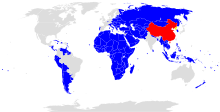
China is the most important supplier of military aid and maintains extensive strategic and military cooperation.[10] Since 1989, China has supplied Myanmar with jet fighters, armored vehicles and naval vessels and has trained Burmese army, air force and naval personnel.[10] Access to Myanmar's ports and naval installations provide China with strategic influence in the Bay of Bengal, in the wider Indian Ocean region and in Southeast Asia.[10][19][73] China has developed a deep-water port on Kyaukpyu in the Bay of Bengal.[94][73] While some sources claimed China has also built an 85-metre jetty, naval facilities and major reconnaissance and electronic intelligence systems on the Great Coco Island, located 18 kilometres from India's Andaman and Nicobar Islands.[95] But the building of intelligence systems on the island is regarded as a myth today and the Indian armed forces recently denied their existence.[96] China assists in constructing a naval base in Sittwe, a strategically important sea port close to eastern India's largest city and port, Kolkata.[95] Beijing also funds road construction linking Yangon and Sittwe, providing the shortest route to the Indian Ocean from southern China.[citation needed]
In recent years, China has shown a lack of willingness to back the Burmese government and has attempted to stabilize the political situation in Myanmar.[72]
In recent years, Myanmar has moved to develop strategic and commercial relations with India, with which it shares a long land border and the Bay of Bengal. Increasing trade and military cooperation with India and developing bilateral relations with Japan and within the Association of South East Asian Nations (ASEAN) shows a shift in Myanmar's foreign policy to avoid excessive dependence on China.[10] However, by 2018 India's involvement in Myanmar was still limited compared to China's political and economic influence in the country.[97][page needed]
Wa State
[edit]The autonomous polity of Wa State within Myanmar's borders, is a strategic issue.[17]: 134–138 In China's analysis, Wa Region could be a buffer zone for disorders including drug trafficking, but only to the extent that Wa State contains instead of amplifies such risks.[17]: 134–135 A strong Wa Region may also be helpful to China in its dealings with Myanmar, but not if actual fighting disturbs Belt and Road Initiative projects in the area.[17]: 134–135
To curb drug trafficking risks, Chinese agencies including the Chinese Border Police, People's Armed Police, Public Security, and the People's Liberation Army have at times been involved in joint border drug enforcement operations.[17]
To address disease risks, China has provided training and medical equipment to the Wa Health Department.[17]: 135
Diplomatic Missions
[edit]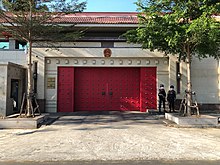
The Myanmar embassy in China is located in Beijing, whilst the Chinese embassy in Myanmar is located in Yangon. Myanmar also maintains consulates in Hong Kong, Kunming and Nanning.[98] China maintains a consulate in Mandalay.[99]
The current Chinese ambassador to Myanmar is Chen Hai. The last ambassador from Myanmar to China was Myo Thant Pe, who served from 2019 until his sudden death in August 2022[100] while in Yunnan province.[101] Neither the State Administration Council nor the National Unity Government of Myanmar have designated a replacement.[102]
See also
[edit]- BCIM Forum
- China–Myanmar border
- Chinese people in Myanmar
- China and the Kachin State
- Foreign relations of Myanmar
- Internal conflict in Myanmar
- Kuomintang in Burma
References
[edit]- ^ a b Maung Aung Myoe (2011). "Sino-Myanmar Relations 1948-1962: The Years of Charting the Water". In the Name of Pauk-Phaw. ISEAS Publishing. pp. 11–56. doi:10.1355/9789814345187-005. ISBN 9789814345187.
- ^ Ministry of Foreign Affairs, the People's Republic of China (29 August 2022). "A Testament to "Pauk-phaw" Friendship".
- ^ Yue, Ricky (2014). "Sino-Myanmar Relations: Is Pauk-Phaw Pragmatic or Rhetoric?". Journal of Comparative Asian Development. 13 (2): 264–289. doi:10.1080/15339114.2014.926805. S2CID 144335156.
- ^ DAVID BREWSTER (8 November 2022). "How China, India and Bangladesh could be drawn into Myanmar's conflict". Lowy Institute.
- ^ a b "China condemns Myanmar border violence". Reuters. 13 May 2018. Archived from the original on 17 February 2019. Retrieved 17 February 2019.
- ^ a b Lt Gen Prakash Katoch (4 December 2023). "Myanmar Aflame". Indian Defence Review. Retrieved 27 January 2024.
China has ties with the Brotherhood Alliance and would probably arm and train some of the refugees; to employ them asymmetrically against Myanmar. This would increase China's clout in Myanmar. But because of the spate of refugees, China also initiated combat training activities along its border with Myanmar on November 25; using armoured vehicles, artillery firing and troop exercises. [...] Yangon recently witnessed anti-China protests (allowed by the government) for supporting armed groups in Myanmar.
- ^ Alfred Stead (1901). China and Her Mysteries. Hood, Douglas, & Howard. pp. 99–.
burma was a tributary state of china british forward tribute peking.
- ^ William Woodville Rockhill (1905). China's Intercourse with Korea from the XVth Century to 1895. Luzac & Company. pp. 5–.
tribute china.
- ^ a b c d e f g h i j k l m n o p q r s t Han, Enze (2024). The Ripple Effect: China's Complex Presence in Southeast Asia. New York, NY: Oxford University Press. ISBN 978-0-19-769659-0.
- ^ a b c d e f g Sudha Ramachandran, Yangon still under Beijing's thumb (11 February 2005). Bangalore, India. Asia Times. Accessed 30 May 2008.
- ^ K. M., Panikkar (1955). In Two Chinas: Memoirs of a Diplomat. Westport: Hyperion Press. p. 68.
- ^ a b Documents of PRC's Foreign Relations: 1949-1950 Vol 1. Beijing: World Knowledge Press. 1957. p. 17.
- ^ "Wilson Center Digital Archive".
- ^ a b Notes on the Establishment of China-Burma Diplomatic Relations, Archive of Ministry of Foreign Affairs of People's Republic of China, File No. 105-00001-01 (1)
- ^ Four Talk Records on the Establishment of China-Burma Relations, Archive of Ministry of Foreign Affairs of People's Republic of China, File No.105-00001-02 (1)
- ^ Aung Myoe, Maung (2011). In the Name of Pauk-Phaw: Myanmar's China Policy Since 1948. Singapore: ISEAS Publishing. p. 21. ISBN 978-981-4345-17-0.
- ^ a b c d e f g h i j k l m n o p q r s Ong, Andrew (2023). Stalemate: Autonomy and Insurgency on the China-Myanmar Border. Cornell University Press. ISBN 978-1-5017-7071-5. JSTOR 10.7591/j.ctv2t8b78b.
- ^ a b Hongwei, Fan (May 2009). "China-Burma Ties in 1954: The Beginning of the "Pauk Phaw" Era". Working Paper Series University of Malaya.
- ^ a b c d e f g h i Sino-Myanmar Relations: Analysis and Prospects Archived 11 July 2020 at the Wayback Machine by Lixin Geng, The Culture Mandala, Vol. 7, no. 2, December 2006. Accessed 30 May 2008.
- ^ Smith, Martin (1 June 1999). Burma: Insurgency and the Politics of Ethnicity. Bloomsbury Academic. pp. 157–8. ISBN 978-1-85649-660-5.
- ^ Shambaugh, David (2000). Power Shift: China and Asia's New Dynamics. Nazrul Institute. p. 218. ISBN 0-520-24570-9.
- ^ "Who is Chinese? The Upper Han". The Economist. 19 November 2016. ISSN 0013-0613. Archived from the original on 14 May 2018. Retrieved 2 January 2017.
- ^ Guan, Ng Han (31 August 2009). Myanmar refugees begin to return home from China[dead link] . Associated Press.
- ^ a b Petty, Martin; Blanchard, Ben (1 September 2009). Myanmar ethnic offensive tests vital China ties Archived 18 December 2018 at the Wayback Machine. Reuters.
- ^ China urges Myanmar to safeguard border stability . Xinhua. 28 August 2009.
- ^ China, Myanmar share responsibility to maintain border stability: FM . Xinhua. 1 September 2009.
- ^ Jagan, Larry (1 September 2009). Border war rattles China-Myanmar ties. Asia Times Online.
- ^ Mcluaghlin & Zaw (11 June 2015). Under pressure from China, Kokang rebels declare Myanmar ceasefire Archived 27 November 2015 at the Wayback Machine. Reuters.
- ^ Jennings, Ralph (25 December 2019). "Myanmar, Though Suspicious of China, Edges Closer to Beijing for Safety". Voice of America. Archived from the original on 29 February 2020. Retrieved 25 December 2019.
- ^ Li, Jason (17 September 2020). "China's Conflict Mediation in Myanmar • Stimson Center". Stimson Center. Retrieved 20 March 2023.
- ^ "Myanmar Signs Historic Cease-Fire Deal With Eight Ethnic Armies". Radio Free Asia. Retrieved 15 October 2017.
- ^ a b John Zaw (16 October 2018). "China-backed militia expels more clergy in northern Myanmar". Union of Catholic Asian News. Archived from the original on 18 February 2019. Retrieved 17 February 2019.
Some Wa officials and their Chinese allies believe that a number of Christian groups contain members aligned to American intelligence organizations.
- ^ "Analysis: 'Debt Trap' Alert Rises in Myanmar as More Belt and Road Projects Scrapped". The Irrawaddy. 18 September 2018. Archived from the original on 26 July 2020. Retrieved 17 February 2019.
- ^ "Myanmar agrees smaller deal for China-backed port after 'debt-trap' concern". Reuters. 8 November 2018. Archived from the original on 11 April 2019. Retrieved 17 February 2019.
- ^ Lintner, Bertil (31 January 2019). "Poor and isolated, Myanmar backs into a China debt trap". Asia Times. Retrieved 29 January 2024.
- ^ "Which Countries Are For or Against China's Xinjiang Policies?". The Diplomat. 15 July 2019. Archived from the original on 11 October 2019. Retrieved 1 August 2019.
- ^ "The Pro-Xinjiang Contingent". Wired. 28 July 2019. Archived from the original on 1 August 2019. Retrieved 1 August 2019.
- ^ Mahtani, Shibani (17 January 2020). "When Xi met Suu Kyi: China embraces Myanmar as Western nations pull back". Washington Post.
- ^ "Xi meets with Myanmar commander-in-chief of defense services". Xinhua News Agency. 18 January 2020. Retrieved 18 January 2020.
- ^ U.S. calls Myanmar military's takeover a coup, while China labels it a "cabinet reshuffle" Archived 21 February 2021 at the Wayback Machine CBS News. Retrieved 20 February 2021
- ^ Rasheed, Z. (18 Feb 2021). "Myanmar protesters urge China to condemn coup. Will Beijing act?" Archived 20 February 2021 at the Wayback Machine AlJAZEERA. Retrieved 20 February 2021
- ^ Solomon, Feliz (15 March 2021). "Chinese Factories Burn in Myanmar's Deadliest Weekend of Protests Since Coup". Wall Street Journal.
- ^ "Attacks on Chinese-run factories in Myanmar vex Beijing". 15 March 2021.
- ^ "Myanmar anti-coup protesters rally at Chinese embassy". Reuters. Archived from the original on 28 June 2021.
- ^ "'It's like a war zone': Life under the Myanmar junta". 3 April 2021.
- ^ Lewis, Simon (6 March 2021). Lobbyist says Myanmar junta wants to improve relations with the West, spurn China Reuters. Retrieved 11 April 2021.
- ^ Leaked Documents Suggest Fraying of China-Myanmar Ties. voanews.com. Retrieved 11 April 2021.
- ^ "'A bloodbath is imminent' in Myanmar but China blocks UN sanctions". April 2021.
- ^ Ebbighausen, Rodion (22 March 2021). "Myanmar coup: Mass protests fail to attract global solidarity | DW | 22.03.2021". Deutsche Welle.
- ^ "Sinopharm: Chinese Covid vaccine gets WHO emergency approval". Reuters. Retrieved 28 May 2021.
- ^ "China Donates 500,000 COVID-19 Vaccines to Myanmar Junta". 3 May 2021.
- ^ Liu, John (17 November 2022). "China Warms Up to Myanmar's Generals". Foreign Policy.
- ^ Kurlantzick, Joshua (4 April 2022). "China's Support for Myanmar Further Shows the World Dividing Into Autocracy versus Democracy". Council on Foreign Relations. Retrieved 24 March 2023.
- ^ Tower, Jason (14 July 2022). "China Bets Strategic Projects, Regional Stability on Myanmar Coup Regime". U.S. Institute of Peace.
- ^ a b Chau, Thompson; Oo, Dominic (11 January 2023). "Did China deliver a snub to Myanmar's military regime?". Al Jazeera. Retrieved 24 March 2023.
- ^ "U Tin Maung Swe appointed as Ambassador of Myanmar to People's Republic of China". 11 November 2022.
- ^ a b Tower, Jason (11 July 2023). "China's Metastasizing Myanmar Problem". United States Institute of Peace.
- ^ a b Gravers, Mikael (19 June 2023). "China's support for Myanmar driven by self-interest". Retrieved 29 June 2023.
- ^ Ramachandran, Sudha (7 July 2023). "China's Collaboration with the Myanmar Junta: A Case of Strategic Hedging?". Jamestown Foundation.
- ^ "The Chinese mafia's downfall in a lawless casino town". BBC News. 23 November 2023.
- ^ A. Clapp, Priscilla; Tower, Jason (8 November 2023). "Myanmar's Junta Is Losing Control of Its Border with China". United States Institute of Peace.
- ^ Zuo, Mandy (12 November 2023). "Chinese police order arrest of alleged Myanmar crime family over telecoms fraud". South China Morning Post. South China Morning Post. Retrieved 14 November 2023.
- ^ "Chinese Authorities Issue Arrest Warrants for Criminal Kingpins in Myanmar's Kokang Region". The Diplomat. 13 November 2023. Retrieved 13 November 2023.
- ^ "In Myanmar, Rebels Make Advances, but Peace Remains a Distant Prospect". Stratfor. 12 December 2023. Archived from the original on 15 December 2023. Retrieved 27 January 2024.
In late November, supporters of the governing junta staged protests in Naypyidaw and Yangon, including outside the Chinese embassy, to protest the perception that China was actively aiding the rebels in their offensive.
- ^ Hawkins, Amy; correspondent, Amy Hawkins Senior China (31 January 2024). "Myanmar hands over junta-backed warlords to China in telecoms scam case". The Guardian.
{{cite news}}:|last2=has generic name (help) - ^ a b c Singh, Swaran (2016). "China Engages Its Southwest Frontiers". The new great game : China and South and Central Asia in the era of reform. Thomas Fingar. Stanford, California: Stanford University Press. p. 156. ISBN 978-0-8047-9764-1. OCLC 939553543.
- ^ a b Myanmar's Ministry of Commerce as of data in 2020 - 2021 Financial Year
- ^ Singh, Swaran (2016). "China Engages Its Southwest Neighbors". The new great game : China and South and Central Asia in the era of reform. Thomas Fingar. Stanford, California: Stanford University Press. ISBN 978-0-8047-9764-1. OCLC 939553543.
- ^ "China sharpens edge in global trade with zero-tariff deal for developing world". South China Morning Post. 29 October 2024. Retrieved 3 December 2024.
- ^ a b Gerstl, Alfred (2023). "China in its Immediate Neighborhood". In Kironska, Kristina; Turscanyi, Richard Q. (eds.). Contemporary China: a New Superpower?. Routledge. ISBN 978-1-03-239508-1.
- ^ Curtis, Simon; Klaus, Ian (2024). The Belt and Road City: Geopolitics, Urbanization, and China's Search for a New International Order. New Haven and London: Yale University Press. ISBN 9780300266900.
- ^ a b c d Chinese dilemma over Burma Archived 15 June 2020 at the Wayback Machine (25 September 2007). BBC. Accessed 30 May 2008.
- ^ a b c India and China compete for Burma's resources Archived 1 June 2020 at the Wayback Machine (21 August 2006). World Politics Review. Accessed 30 May 2008.
- ^ Perlez, Jane; Feng, Bree (18 May 2013). "Under Pressure, China Measures Its Impact in Myanmar". The New York Times. Archived from the original on 25 December 2016. Retrieved 26 February 2017.
- ^ Guo Aibing (4 October 2011). "China Power Investment Says Myanmar Dam Halt Is 'Bewildering'". Bloomberg. Archived from the original on 5 November 2013. Retrieved 6 March 2017.
- ^ a b c d e Jonathan Watts (4 October 2011). "China angry over Myanmar's decision to suspend work on £2.3bn dam". The Guardian. London. Archived from the original on 8 March 2016. Retrieved 11 December 2016.
- ^ "Myanmar rare earths heading toward China encounter shipment obstacles amid upheaval". Reuters. Retrieved 27 October 2021.
- ^ "Opium, rubber, and a land grab on Myanmar's border with China". East–West Center. Archived from the original on 3 July 2020. Retrieved 2 July 2020.
- ^ Joseph J. Schatz (26 August 2013). "Myanmar's land-grab problem". Bangkok Post.
- ^ "Burma confirms phosphorus used at mine protest". BBC. 12 March 2013. Retrieved 30 November 2023.
- ^ a b "Interview: Myanmar: Suspend copper mine linked to ongoing human rights abuses". Amnesty International. 10 February 2017. Archived from the original on 7 August 2020. Retrieved 2 July 2020.
- ^ a b "Kidnapped". The Economist. 24 May 2014. ISSN 0013-0613. Archived from the original on 7 March 2023.
- ^ Ferrie, Jared (19 May 2014). "Chinese workers abducted from Myanmar mine are freed". Reuters. Archived from the original on 16 May 2021.
- ^ "Myanmar villagers free abducted Chinese mine workers". BBC. 19 May 2014. Retrieved 30 November 2023.
- ^ "Myanmar: Banana Plantation owned by Chinese companies raises local concerns over land and environmental problems". Business & Human Rights Resource Centre. Archived from the original on 2 July 2020. Retrieved 2 July 2020.
- ^ "Chinese joint venture assaults two journalists in Kachin: local media". The Myanmar Times. 26 February 2019. Archived from the original on 2 July 2020. Retrieved 2 July 2020.
- ^ "Chinese companies top human rights 'dirty list' of firms complicit in Myanmar violations". South China Morning Post. The Guardian. 13 December 2018. Archived from the original on 3 July 2020. Retrieved 2 July 2020.
- ^ Lawler, Dave (2 July 2020). "The 53 countries supporting China's crackdown on Hong Kong". Axios. Archived from the original on 4 July 2020. Retrieved 3 July 2020.
- ^ "Interview: Why 'Brides' From Myanmar Are Trafficked to China". Human Rights Watch. 21 March 2019. Archived from the original on 15 June 2020. Retrieved 2 July 2020.
- ^ "Thousands of Myanmar women forced into marriages in China". Deutsche Welle. 7 December 2018. Archived from the original on 25 March 2020. Retrieved 2 July 2020.
- ^ "Police bust Chinese bride-for-sale trafficking gang". Anadolu Agency. Retrieved 30 November 2023.
- ^ "China seizes 31 trafficking suspects holding Myanmar women". Reuters. 24 November 2014. Archived from the original on 18 May 2021.
- ^ Hackney, Laura K. (15 April 2015). "Re-evaluating Palermo: The case of Burmese women as Chinese brides". Anti-Trafficking Review (4): 98–119. doi:10.14197/atr.20121546. ISSN 2287-0113.
It is clearly the case that some women from Burma are deceived and forced to marry Chinese men against their will. However, my research shows that many of these same women, when given options, chose to remain in their Chinese marriages. This is just one example. Other women choose to be sold to Chinese men, and others return home to Burma after the birth of their first child. [...] In this case, she is able to fashion better economic conditions for herself and achieve her own personal hypergamy within her new social group or community. Burmese brides have also been documented working outside the home and sending remittances to their families across the border.
- ^ Lintner, Bertil (15 April 2019). The Costliest Pearl: China's Struggle for India's Ocean. Oxford University Press. pp. 35–61. ISBN 978-1-78738-239-8.
- ^ a b Tony Allison. Myanmar shows India the road to Southeast Asia (21 February 2001). AsiaTimes. Accessed 30 May 2008.
- ^ "Chinese Whispers: The Great Coco Island Mystery". www2.irrawaddy.org. Archived from the original on 3 March 2011. Retrieved 18 April 2018.
- ^ Stokke, Kristian; Vakulchuk, Roman and Indra Overland (2018) Myanmar: A Political Economy Analysis Archived 28 July 2020 at the Wayback Machine. Norwegian Institute of International Affairs (NUPI). Report commissioned by the Norwegian Ministry of Foreign Affairs.
- ^ "Consulate General in China". Embassy of the Republic of the Union of Myanmar Beijing, China. Retrieved 18 December 2022.
- ^ "Introduction of Consulate General in Mandalay". Embassy of the People's Republic of China in the Republic of the Union of Myanmar. 26 August 2020. Retrieved 18 December 2022.
- ^ "Myanmar's ambassador to China dies". AP News. 8 August 2022.
- ^ "Myanmar ambassador to China died on Sunday: sources". The Jakarta Post. Retrieved 18 December 2022.
- ^ "Embassy Staffs". Embassy of the Republic of the Union of Myanmar Beijing, China. Retrieved 18 December 2022.
Bibliography
[edit]- Cardenal, Juan Pablo; Araújo, Heriberto (2011). La silenciosa conquista china (in Spanish). Barcelona: Crítica. pp. 95–107, 230–232. ISBN 9788498922578.
- Lanuzo, Steve L. "The Impact of Political Liberalization on Sino Myanmar Cooperation" (Naval Postgraduate School, 2018) online Archived 28 July 2020 at the Wayback Machine.
- Narayanan, Raviprasad. "China and Myanmar: Alternating between ‘Brothers’ and ‘Cousins’." China Report 46.3 (2010): 253–265 online.
- Yian, Goh Geok. 2010. “The Question of 'china' in Burmese Chronicles”. Journal of Southeast Asian Studies 41 (1): 125–52. The Question of 'China' in Burmese Chronicles.

